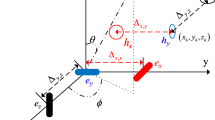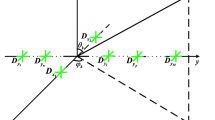Abstract
In this paper, a new spatially spread electromagnetic vector sensor (SS-EMVS) is proposed by a two-step design. In addition, a novel DOA estimator with coarse-fine estimate combination is presented for the proposed array. The first step aims to make the configurations of SS-EMVS satisfy the “vector cross-product” estimator, leading to a coarse estimation of three direction-cosines. The second step focuses on extending the two dimensional (2-D) array apertures of SS-EMVS, resulting in two fine but ambiguous estimations on the direction-cosines by extracting inter-sensor phase-delay. Combination the coarse and fine estimations, the high-accuracy 2-D DOA estimation can be obtained by using the coarse estimation to disambiguate the fine estimation. The three- dipoles and loops of the proposed configuration are located separately, which are found to reduce mutual coupling as compared with collocated EMVS. Moreover, the new configuration is able to extend 2-D array aperture to improve the accuracy of 2-D direction-finding. Numerical Simulations are conducted to demonstrate the effectiveness of the proposed algorithm.









Similar content being viewed by others
References
Au Yeung, C. K., & Wong, K. T. (2009). CRB: Sinusoid-sources’ estimation using collocated dipoles/loops. IEEE Transactions on Aerospace and Electronic Systems, 45(1), 94–109.
Bihan, N. L., & Mars, J. (2004). Singular value decomposition of quaternion matrices: A new tool for vector-sensor signal processing. Signal Processing, 84(7), 1177–1199.
Bihan, N. L., Miron, S., & Mars, J. (2007). MUSIC algorithm for vector-sensors array using biquaternions. IEEE Transactions on Signal Processing, 55(9), 4523–4533.
Cao, J (2014). Survey on acoustic vector sensor and its applications in signal processing. In proceedings of the 33rd Chinese Control Conference (CCC2014), pp. 7456–7461, Nanjing, China, Jul. 28–30.
Cao, J., Khong, AW., & Gannot, S (2014). On the performance of widely linear Quaternion based MVDR beamformer for an acoustic vector sensor. In proceedings of the international workshop on acoustic signal enhancement (IWAENC 2014), Juan les Pins, French Riviera, Sep. 8–11.
Cao, Jiuwen, & Lin, Zhiping. (2014). Bayesian signal detection with compressed measurements. Information Sciences, 289, 241–253.
Chiu, C. Y., Yan, J. B., Murch, R. D., et al. (2009). Design and implementation of a compact 6-port antenna. IEEE Antennas and Wireless Propagation Letters, 8, 767–770.
Gong, X. F., Liu, Z. W., & Xu, Y. G. (2008). Quad-quaternion MUSIC for DOA estimation using electromagnetic vector sensors. EURASIP Journal on Advances in Signal Processing, 2008, 1–14.
Gong, X. F., Liu, Z. W., & Xu, Y. G. (2011). Regularised parallel factor analysis for the estimation of direction-of-arrival and polarisation with a single electromagnetic vector-sensor. IET Signal Processing, 5(4), 390–396.
Gong, X. F., Liu, Z. W., & Xu, Y. G. (2011). Coherent source localization: Bicomplex polarimetric smoothing with electromagnetic vector-sensors. IEEE Transactions on Aerospace and Electronic Systems, 47(3), 2268–2285.
Gong, X. F., Liu, Z. W., & Xu, Y. G. (2011). Direction finding via biquaternion matrix diagonalization with vector-sensors. Signal Processing, 91(4), 821–831.
Gu, C., He, J., Li, H., et al. (2013). Target localization using MIMO electromagnetic vector array systems. Signal Processing, 93(7), 2103–2107.
Guo, X., Miron, S., Brie, D., et al. (2011). A CANDECOMP/PARAFAC perspective on uniqueness of DOA estimation using a vector sensor array. IEEE Transactions on Signal Processing, 59(7), 3475–3481.
He, J., & Liu, Z. (2009). Computationally efficient 2D direction finding and polarization estimation with arbitrarily spaced electromagnetic vector sensors at unknown locations using the propagator method. Digital Signal Processing, 19(3), 491–503.
He, J., Jiang, S., Wang, J., et al. (2010). Polarization difference smoothing for direction finding of coherent signals. IEEE Transactions on Aerospace and Electronic Systems, 46(1), 469–480.
Ho, K. C., Tan, K. C., & Ser, W. (1995). An investigation on number of signals whose directions of arrival are uniquely determinable with an electromagnetic vector sensor. Signal Processing, 47(1), 41–54.
Hurtado, M., & Nehorai, A. (2007). Performance analysis of passive low-grazing-angle source localization in maritime environments using vector sensors. IEEE Transactions on Aerospace and Electronic Systems, 43(2), 780–789.
Ko, C. C., Zhang, J., & Nehorai, A. (2002). Separation and tracking of multiple broadband sources with one electromagnetic vector sensor. IEEE Transactions on Aerospace and Electronic Systems, 38(3), 1109–1116.
Lemma, A. N., Veen, A. J., & Deprettere, E. F. (1999). Multiresolution ESPRIT algorithm. IEEE Transactions on Signal Processing, 47(6), 1722–1726.
Li, Yang, & Zhang, Jianqiu. (2013). An Enumerative NonLinear Programming approach to direction finding with a general spatially spread electromagnetic vector sensor array. Signal Processing, 93(4), 856–865.
Liang, J., Liu, D., & Zhang, J. (2009). Joint frequency, 2-D DOA, and polarization estimation using parallel factor analysis. Science in China Series F Information Sciences, 52(10), 1891–1904.
Luo, F., & Yuan, X. (2012). Enhanced “vector-cross-product” direction-finding using a constrained sparse triangular-array. EURASIP Journal on Advances in Signal Processing, 2012, 115. doi:10.1186/1687-6180-2012-115.
Miron, S., Bihan, N. L., & Mars, J. (2006). Quaternion-MUSIC for vector-sensor array processing. IEEE Transactions on Signal Processing, 54(4), 1218–1229.
Monte, L. L., Elnour, B., Erricolo, D. (2007). Distributed 6D vector antennas design for direction of arrival application. IEEE international conference on electromagnetics in advanced applications, pp. 431–434.
Monte, L. L., Elnour, B., Erricolo, D., et al. (2007). Design and realization of a distributed vector sensor for polarization diversity applications. IEEE international waveform diversity and design conference, pp. 358–361.
Nehorai, A., & Paldi, E. (1994). Vector-sensor array processing for electromagnetic source localization. IEEE Transactions on Signal Processing, 42(2), 376–398.
Nehorai, A., & Tichavsky, P. (1999). Cross-product algorithms for source tracking using an EM vector sensor. IEEE Transactions on Signal Processing, 47(10), 2863–2867.
Rahamim, D., Tabrikian, J., & Shavit, R. (2004). Source localization using vector sensor array in a multipath environment. IEEE Transactions on Signal Processing, 52(11), 3096–3103.
See, C. M. S., & Nehorai, A. (2003). Source localization with distributed electromagnetic component sensor array processing. IEEE 7th international symposium on signal processing and its applications, pp. 177–180.
Tan, K. C., Ho, K. C., & Nehorai, A. (1996). Linear independence of steering vectors of an electromagnetic vector sensor. IEEE Transactions on Signal Processing, 44(12), 3099–3107.
Tan, K. C., Ho, K. C., & Nehorai, A. (1996). Uniqueness study of measurements obtainable with arrays of electromagnetic vector sensors. IEEE Transactions on Signal Processing, 44(4), 1036–1039.
Trees, H. L. (2002). Detection, estimation, and modulation theory, Part IV: Optimum array processing. New York: Wiley.
Wong, K. T., & Zoltowski, M. D. (1997). Uni-vector-sensor ESPRIT for multi-source azimuth, elevation, and polarization estimation. IEEE Transactions on Antennas and Propagation, 45(10), 1467–1474.
Wong, K. T., & Zoltowski, M. D. (2000). Self-initiating MUSIC direction finding and polarization estimation in spatio-polarizational beamspace. IEEE Transactions on Antennas and Propagation, 48(8), 1235–1245.
Wong, K. T., & Zoltowski, M. D. (2000). Closed-form direction-finding with arbitrarily spaced electromagnetic vector-sensors at unknown locations. IEEE Transactions on Antennas and Propagation, 48(5), 671–681.
Wong, K. T. (2001). Geolocation/beamforming for multiple wideband-FFH with unknown hop sequences. IEEE Transactions on Aerospace and Electronic System, 37(1), 65–76.
Wong, K. T. (2001). Direction finding/polarization estimation–dipole and/or loop triad(s). IEEE Transactions on Aerospace and Electronic Systems, 37(2), 679–684.
Wong, K. T., & Yuan, X. (2011). ’Vector cross-product direction-finding’ with an electromagnetic vector-sensor of six orthogonally oriented but spatially non-collocating dipoles/loops. IEEE Transactions on Signal Processing, 59(1), 160–171.
Xu, Y., & Liu, Z. (2007). Polarimetric angular smoothing algorithm for an electromagnetic vector sensor array. IET Radar Sonar Navigation, 1(3), 230–240.
Yuan, X. (2012). Diversely polarized antenna-array signal processing. Ph.D. dissertation, Hong Kong, The Hong Kong Polytechnic University.
Yuan, X. (2012). Polynomial-phase signal source-tracking using an electromagnetic vector-sensor. IEEE 37th international conference on acoustics, speech and signal processing, pp. 2577–2580.
Yuan, X. (2012). Quad compositions of collocated dipoles and loops: For direction finding and polarization estimation. IEEE Antennas and Wireless Propagation Letters, 11, 1044–1047.
Yuan, X. (2012). Estimating the DOA and the polarization of a polynomial-phase signal using a single polarized vector-sensor. IEEE Transactions on Signal Processing, 60(3), 1270–1282.
Yuan, X., Wong, K. T., & Agrawal, K. (2012). Polarization estimation with a dipole-dipole pair, a dipole-loop pair, or a loop-loop pair of various orientations. IEEE Transactions on Antennas and Propagation, 60(5), 2442–2452.
Yuan, X., Wong, K. T., Xu, Z., et al. (2012). Various triads of collocated dipoles/loops, for direction finding and polarization estimation. IEEE Sensors Journal, 12(6), 1763–1771.
Zoltowski, M. D., & Wong, K. T. (2000). ESPRIT-based 2-D direction finding with a sparse array of electromagnetic vector-sensors. IEEE Transactions on Signal Processing, 48(8), 2195–2204.
Zoltowski, M. D., & Wong, K. T. (2000). Closed-form eigenstructure-based direction finding using arbitrary but identical subarrays on a sparse uniform rectangular array grid. IEEE Transactions on Signal Processing, 48(8), 2205–2210.
Author information
Authors and Affiliations
Corresponding author
Appendix A: Derivation of the CRB for a single arbitrary SS-EMVS
Appendix A: Derivation of the CRB for a single arbitrary SS-EMVS
The output signal is modeled as: \({\varvec{x}}(t)=\sum \limits _{k=1}^{K}{\tilde{{\varvec{a}}}_{k}s_{k}(t)} +{\varvec{n}}(t)\), where \(\tilde{{\varvec{a}}}\) is defined in (3), \(s_{k}(t)=\sigma _{s}\exp (j2\pi f_{k}t+j\varepsilon )\) denotes uncorrelated pure tones with different frequencies, which is the same as given in Wong and Zoltowski (1997); Monte et al. (2007); Luo and Yuan (2012) and Au Yeung and Wong (2009). \({\varvec{n}}(t)\) denotes Gaussian random process with zero-mean and covariance \(\sigma _{n}^{2}\). The analysis method of Au Yeung and Wong (2009) can be used to derivate the CRBs for a single arbitrary SS-EMVS, as follows.
The data sampling instants occur at \(t=l/f_{s}\), where \(f_{s}\) denotes the sampling frequency. We collect all \(L\) snapshots into a \(6L\times 1\) data-set: \({\varvec{y}}=[{\varvec{x}}(1/{f_{s}})^{T},{\varvec{x}} (2/{f_{s}})^{T},\cdots {\varvec{x}}(L/{f_{s}})^{T}]^{T}\). The mean of \({\varvec{y}}\) equals \({\varvec{\mu }}=\sum \limits _{k=1}^{K}{{\varvec{s}}_{k}\otimes \tilde{{\varvec{a}}}_{k}} \), where \({\varvec{s}}_{k}=\sigma _{s}\exp (j\varepsilon )[\exp (j2\pi f_{k}^{\prime }),\exp (j4\pi f_{k}^{\prime }),\cdots ,\exp (j2L\pi f_{k}^{\prime })]^{T}\), \(f_{k}^{\prime } ={f_{k}}/{f_{s}}\) denotes digital frequency. Note that the source parameters \(\left\{ {\sigma _{s},\varepsilon ,f_{k}^{\prime }} \right\} \) will affect the CRB. The covariance of\({\varvec{y}}\) equals \({\varvec{R}}=\sigma _{n}^{2}{\varvec{I}}_{6L} \). Therefore, \({\varvec{y}}\sim {\mathcal {N}}_{c}({\varvec{\mu }},{\varvec{R}})\). Then the \((i,j)\)th entry of the Fisher Information Matrix (FIM) is (Trees 2002, Eq. (8.34)):
where \({\varvec{\psi }}=[\theta ,\phi ,\gamma ,\eta ]^{T}\) is the vector of parameters to be estimated. Note that \(\frac{\partial {\varvec{\mu }}}{\partial \psi _{i}}=\frac{\partial \sum \limits _{k=1}^{K}{{\varvec{s}}_{k}\otimes \tilde{{\varvec{a}}}_{k}}}{\partial \psi _{i}}={\varvec{s}}_{i}\otimes \frac{\partial \tilde{{\varvec{a}}}_{i}}{\partial \psi _{i}}\). Then the FIM can be simplified to:
where \(c_{ij} =\exp [j2\pi (f_{j}^{\prime } -f_{i}^{\prime })]+\exp [j4\pi (f_{j}^{\prime } -f_{i}^{\prime })]+\cdots +\exp [j2L\pi (f_{j}^{\prime } -f_{i}^{\prime })]\). In the following, we list the relevant derivatives of the array manifold \(\tilde{{\varvec{a}}}\) in (32). When \(\psi \) denotes the elevation angle:
where \(\{{\varvec{\varPhi }} (\theta ,\phi ),{\varvec{g}}(\gamma ,\eta )\}\) and \({\varvec{d}}(\theta ,\phi )\) are defined in (1) and (3), respectively,
and
When \(\psi \) denotes the azimuth angle:
where
and
When \(\psi \) denotes the auxiliary polarization angle:
where \({\varvec{c}}_{5}=\left[ {\cos \gamma e^{j\eta },-\sin \gamma }\right] ^{T}\). When \(\psi \) denotes the polarization phase difference:
where \({\varvec{c}}_{6}=\left[ {j\sin \gamma e^{j\eta },0}\right] ^{T}\).
Rights and permissions
About this article
Cite this article
Zheng, G. A novel spatially spread electromagnetic vector sensor for high-accuracy 2-D DOA estimation. Multidim Syst Sign Process 28, 23–48 (2017). https://doi.org/10.1007/s11045-015-0327-6
Received:
Revised:
Accepted:
Published:
Issue Date:
DOI: https://doi.org/10.1007/s11045-015-0327-6




